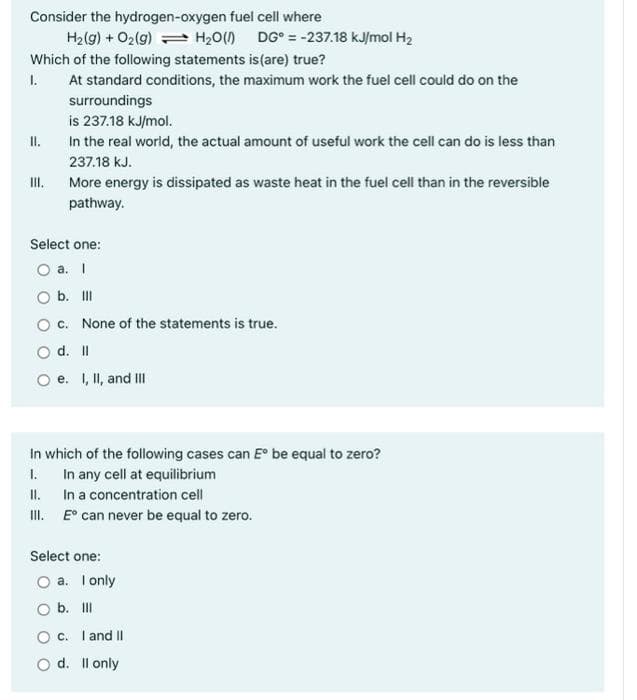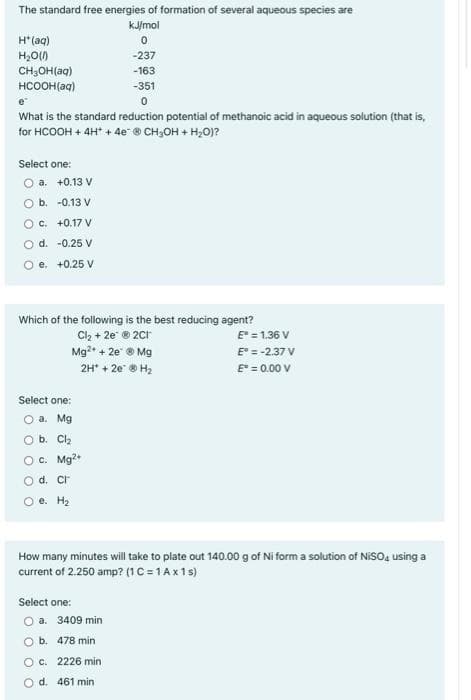Consider the hydrogen-oxygen fuel cell where H2(g) + O2(g) = H20() DG° = -237.18 kJ/mol H2 Which of the following statements is(are) true? 1. At standard conditions, the maximum work the fuel cell could do on the surroundings is 237.18 kJ/mol. II. In the real world, the actual amount of useful work the cell can do is less than 237.18 kJ. More energy is dissipated as waste heat in the fuel cell than in the reversible pathway. II. Select one: O a. I O b. II O c. None of the statements is true. O d.I O e. 1, II, and II In which of the following cases can E° be equal to zero? In any cell at equilibrium II. In a concentration cell II. E° can never be equal to zero. 1. Select one: O a. T only O b. II O c. I and || O d. Il only
Consider the hydrogen-oxygen fuel cell where H2(g) + O2(g) = H20() DG° = -237.18 kJ/mol H2 Which of the following statements is(are) true? 1. At standard conditions, the maximum work the fuel cell could do on the surroundings is 237.18 kJ/mol. II. In the real world, the actual amount of useful work the cell can do is less than 237.18 kJ. More energy is dissipated as waste heat in the fuel cell than in the reversible pathway. II. Select one: O a. I O b. II O c. None of the statements is true. O d.I O e. 1, II, and II In which of the following cases can E° be equal to zero? In any cell at equilibrium II. In a concentration cell II. E° can never be equal to zero. 1. Select one: O a. T only O b. II O c. I and || O d. Il only
Chemistry: An Atoms First Approach
2nd Edition
ISBN:9781305079243
Author:Steven S. Zumdahl, Susan A. Zumdahl
Publisher:Steven S. Zumdahl, Susan A. Zumdahl
Chapter17: Electrochemistry
Section: Chapter Questions
Problem 135CWP: Consider a galvanic cell based on the following half-reactions: a. What is the expected cell...
Related questions
Question
4

Transcribed Image Text:Consider the hydrogen-oxygen fuel cell where
H2(g) + O2(g) = H20() DG° = -237.18 kJ/mol H2
Which of the following statements is(are) true?
1.
At standard conditions, the maximum work the fuel cell could do on the
surroundings
is 237.18 kJ/mol.
II.
In the real world, the actual amount of useful work the cell can do is less than
237.18 kJ.
I.
More energy is dissipated as waste heat in the fuel cell than in the reversible
pathway.
Select one:
O a. I
b. II
O c. None of the statements is true.
d. I
O e. I, II, and II
In which of the following cases can E° be equal to zero?
1.
In any cell at equilibrium
II. In a concentration cell
I. E° can never be equal to zero.
Select one:
a. I only
O b. II
O c. I and ||
O d. Il only

Transcribed Image Text:The standard free energies of formation of several aqueous species are
kJ/mol
H*(aq)
H20()
CH;OH(aq)
HCOOH(aq)
-237
-163
-351
e
What is the standard reduction potential of methanoic acid in aqueous solution (that is,
for HCOOH + 4H* + 4e ® CH;OH + H;O)?
Select one:
О а. +0.13 V
O b. -0.13 V
O c. +0.17 V
O d. -0.25 V
O e. +0.25 V
Which of the following is the best reducing agent?
Cl, + 2e ® 2Cr
Mg? + 2e ® Mg
E° = 1.36 V
E = -2.37 V
2H* + 2e ® H2
E° = 0.00 V
Select one:
O a. Mg
O b. Cl2
Oc. Mg?+
O d. cr
O e. H2
How many minutes will take to plate out 140.00 g of Ni form a solution of NISO, using a
current of 2.250 amp? (1C = 1Ax1s)
Select one:
O a. 3409 min
O b. 478 min
O c. 2226 min
O d. 461 min
Expert Solution
This question has been solved!
Explore an expertly crafted, step-by-step solution for a thorough understanding of key concepts.
This is a popular solution!
Trending now
This is a popular solution!
Step by step
Solved in 3 steps with 2 images

Knowledge Booster
Learn more about
Need a deep-dive on the concept behind this application? Look no further. Learn more about this topic, chemistry and related others by exploring similar questions and additional content below.Recommended textbooks for you

Chemistry: An Atoms First Approach
Chemistry
ISBN:
9781305079243
Author:
Steven S. Zumdahl, Susan A. Zumdahl
Publisher:
Cengage Learning

Chemistry
Chemistry
ISBN:
9781305957404
Author:
Steven S. Zumdahl, Susan A. Zumdahl, Donald J. DeCoste
Publisher:
Cengage Learning


Chemistry: An Atoms First Approach
Chemistry
ISBN:
9781305079243
Author:
Steven S. Zumdahl, Susan A. Zumdahl
Publisher:
Cengage Learning

Chemistry
Chemistry
ISBN:
9781305957404
Author:
Steven S. Zumdahl, Susan A. Zumdahl, Donald J. DeCoste
Publisher:
Cengage Learning


Chemistry: Principles and Reactions
Chemistry
ISBN:
9781305079373
Author:
William L. Masterton, Cecile N. Hurley
Publisher:
Cengage Learning

Principles of Modern Chemistry
Chemistry
ISBN:
9781305079113
Author:
David W. Oxtoby, H. Pat Gillis, Laurie J. Butler
Publisher:
Cengage Learning

Chemistry by OpenStax (2015-05-04)
Chemistry
ISBN:
9781938168390
Author:
Klaus Theopold, Richard H Langley, Paul Flowers, William R. Robinson, Mark Blaser
Publisher:
OpenStax